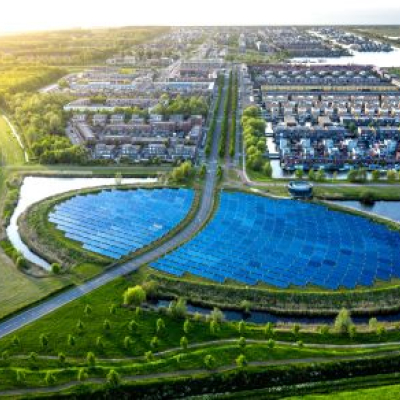Climate change affects everyone – from villagers in the most remote parts of the world, to metropolitan heads of government and private sector leaders. Amid a changing political landscape and an increase in climate impacts, dialogue and collaboration are needed more than ever to make a lasting difference.
The past years have seen a mainstreaming of climate issues following the 2015 Paris Agreement and COP21, laying out emission reduction requirements to keep global temperature rise below two degrees Celsius.
While these multilateral contexts provide a crucial framework, meeting the requirements will require a truly varied engagement – NGOs, aid workers, diplomats, municipal authorities, and state militaries, among others, all have a role to play.
The International Conference on Enhancing Climate Diplomacy in a Changing Political Environment, held in late November in Brussels, presented a chance for stakeholders to come together around the common theme of climate diplomacy. From new technologies to security implications, the conference provided a platform for participants to leverage in building partnerships and exchanging best practices.
Capacity4dev caught up with three participants to learn about the work they are doing in their respective spheres of influence – a non-profit research organisation, the United Nations Environment Programme (UN Environment), and the military of Pakistan. While vastly different as actors, each brought a new perspective and insights into modes of engagement, demonstrating just how connected the world is when it comes to the climate we share.
Harnessing the data revolution
Kitty van der Heijden, Director of Europe and Africa at the World Resources Institute, sat down with us to discuss the role of data in making sense of climate change and the new tools it can power in countering environmentally-destructive practices.
“Data is extremely important,” van der Heijden said. “It has the potential to really create disruptive change… it is in our hands whether this creates a positive change, or a negative one.” Pointing to the steam revolution that powered the 19th century and the use of oil in the 20th, she explained that data will be the driving force of our time.
“Data is extremely important... It has the potential to really create disruptive change”
“Where we are now is in a data revolution,” she said. “With our processing capacity, we can get data to talk to each other.” Doing so provides the bigger picture – deciphering just how changes to the natural environment impact communities, regions, and nations.
The challenge, she said, is to connect data and analysis often held in different spheres of focus. The sheer quantity of data and disparity in sources means that collecting and presenting it in a way that decision-makers can understand is crucial. Data-informed policy making would constitute a major step forward in addressing climate change, explained van der Heijden.
“We need to connect the data and policy dots between defence, diplomatic and development communities – and make sure that environmental degradation is taken seriously as a risk multiplier for tensions within and between societies.”
Making sense of it
The World Resources Institute focuses on interconnected issues – food, water, forests, cities, energy and climate, among others – with data being at the centre of their work. The Institute has been building a platform to address the need for integrated analysis, powered by the best data available; Resource Watch is set to be released in April 2018.
Resource Watch will bring together over 300 data sets – around 50 of which are being updated in near real-time – in partnership with NASA, Google, the UN, and the World Bank, among others.
The platform will map how biophysical change (such as climate change, soil degradation, and water scarcity) impacts the socioeconomic (such as food security and health), along with the ways in which it may exacerbate political marginalization, exclusion, and migration.
For van der Heijden, Resource Watch’s integrated data will both demonstrate the political relevance of ecological degradation, providing an impetus to act, while functioning as an important tool for those in decision and policy making positions.
Democratising data
The World Resources Institute aspires to do more than drive policy change. “We need to democratise data, mobilise the masses and create a movement,” van der Heijden said. “Combining satellite data and social media, you can actually get things done.”
Watch Kitty van der Heijden discuss data and the work of the World Resources Institute here:
Referring to the work of Global Forest Watch (which the Institute has set up a small fund to support), van der Heijden explained that new technologies can enable every citizen to track and act against deforestation in the areas they live and care about.
Through setting automated alerts tied to the detection of deforestation by satellites, the platform’s users can get information – in near real-time – on where it’s occurring. These alerts enable them to mobilise their communities and the media against illegal practices and hold the culprits accountable – be they municipal authorities or international companies.
“Empowering local people is a crucial way to make change happen,” van der Heijden explained. “You have to give people the tools to have agency over their own lives and their own destiny… Big data can now show that the bad guys can’t hide anymore. Global data should empower local communities to be a part of the accountability chain.”
Building capacity
A senior advisor to the Post-Conflict and Disaster Management Branch at UN Environment who worked in Afghanistan between 2004 and 2008 – during the time of the transitional government of Afghanistan and the first government to be elected after the fall of the Taliban regime.
“In fragile countries, there are multiple risks - when climate change comes, it acts as a risk multiplier”
“In fragile countries, there are multiple risks,” explained, “when climate change comes, it acts as a risk multiplier.” While many of these risks may be difficult to address – such as governance breakdowns – he believes that the science on climate is strong enough for it to be an area where effective action can be taken.
For him, understanding the impact of climate on political hotspots is a first step in developing a response. By presenting climate-sensitive solutions, the overall degree of instability can be reduced and associated risks better managed.
The context of Afghanistan
Afghanistan provides a concrete example of the measures that can be taken to address environmental issues in a fragile state.
Afghanistan’s transitional government, which came into existence in 2002, requested that UN Environment conduct a post-conflict environmental assessment. Following the release of the findings in 2003, UN Environment was asked to implement some of the 156 advisory outcomes of the report, leading to the establishment of an office in the country.
“One of the major problems at that stage was that during the 30 years of war, the institutions were decimated,” he said. This extended from the governmental down to the village level, where a mismanagement of natural resources under armed groups resulted in the destruction of local ecosystems.
“Our first task in Afghanistan was to help the government revive the institutions at all levels,” he said. This was followed by assisting the government in creating policies and legislations to adequately manage resources – though, it was clear that these would not be enough on their own.
“During the civil war, between 2.5 and 3 million refugees fled to Pakistan, while another 1 to 1.5 million fled to Iran,” he continued. “Large-scale migration meant there was not much capacity left, both technical and managerial.” The next step was to establish training programmes for large numbers of people, in order to redevelop the human know-how required to effectively carry out the implementation of environmental policies.
The final step, he explained, was to have people see with their own eyes the potential impact of environmental regeneration. UN Environment launched a series of pilot projects to show people that rivers, forests, and grazing lands could all be revived – building the faith needed to achieve engagement for a lasting impact.
Military as agent of change
While armed forces in Afghanistan contributed to environmental degradation in the country, Lieutenant General (retired) Tariq Waseem Ghazi, former Defence Secretary of the Government of Pakistan, highlighted the positive role militaries can play through climate diplomacy.
“Climate change is an issue that has not been on the radar in Pakistan,” he said, adding that the difficulties in promoting environmentally friendly measures have largely stemmed from a lack of climate awareness across the country.
A common belief that climate change was created by other nations – and should therefore be solved by them – along with a concern for more pressing issues, such as hunger and poverty, have meant that climate change has too often been overlooked. “The big task is to get people to understand that climate change threatens all of us,” Ghazi said.
The 2005 earthquake and floods in 2010 and 2011 played a part in increasing climate awareness in the country – though a more proactive engagement is required if the worst effects of climate change are to be mediated, he believes.
“The big task is to get people to understand that climate change threatens all of us"
For this reason, Ghazi chose to teach about the link between security and climate change at the National Defence University of Pakistan – targeting the mid to high-level officers who go through training before assuming policy making positions in their later careers.
Ghazi explained that the military also plays an important role as first responders to environmental disasters in Pakistan, managing large relief and rehabilitation efforts. Training the military on environmental management and in recognising early warning signs can improve their ability to react and pre-empt disasters.
Transnational security
“Climate change is a national security risk,” Ghazi said, emphasising that militaries can help catalyse change by making their national governments aware of the implications of a changing climate.
Ghazi gave the example of the Tibetan plateau, the source of most major rivers flowing across the Asian continent. “It is a place from where water emanates for what is perhaps more than half of humanity,” he explained. For this reason, the source countries have a responsibility to those whose water supplies are fed by the rivers flowing from the plateau, he said. “There will always be problems to be found with the resource allocation.”
According to Ghazi, while some treaties (like the Indus Water Treaty of 1960 between India and Pakistan) exist to manage the allocation of water – including arbitration mechanisms for potential disputes – a changing climate has put these under stress.
“While all the negotiations and arbitration are going on, this just delays the whole process,” he said. “Meanwhile, the threats on the ground continue to gain momentum.”
Watch Lt. Gen. (Ret.) Tariq Waseem Ghazi explain how climate diplomacy can be employed by the military here:
In times of drought and scarcity, cross-border tensions can be amplified by these realities, with the military’s focus centring in on how to keep the water flowing. “Military considerations and national security take resource allocation into mind, and this can raise tensions when there should be efforts directed at resolutions,” Ghazi explained.
The flow of nearly 7 million refugees from the Soviet-occupied Afghanistan to Pakistan resulted in a considerable strain on Pakistan, he added. From societal tensions, which can lead to internal turmoil, or a lack of adequate resources to deal with a refugee crisis, “external problems can quickly become an internal problem, and vice versa”.
Conceptualisation and cooperation
For Ghazi, the most important thing that can be done for climate diplomacy is to ensure a good knowledge-base for actors to draw on. In order to do this, adequate resources need to be provided to properly map the risks that climate change poses and ensure that the findings reach those in a position to use the information.
“We need to make people aware through research and by developing scenarios on how climate change will create specific security threats,” he said.
“Once you’ve hypothesised the threat, you can create a response. From the response, you will develop an action plan. This can then direct the different ministries on what they each have to do, individually and collectively – forming a mechanism for cooperation.”
Ghazi further emphasised the need for strong transnational and multisectoral forums to ensure a comprehensive understanding of the problems, contributing to the formulation of appropriate responses. Lastly, he pointed to the need for interactive platforms to facilitate better funding allocation.
“Climate change is an issue that does not respect boundaries,” he concluded. Without collaboration that bridges sectoral and national divisions, we risk being caught out.
Image credit: DFID/Russell Watkins via Creative Commons license 2.0
This article was written by Craig Hill, Journalist and Content Editor at Capacity4dev, with input from DG DEVCO and UNEP.







Log in with your EU Login account to post or comment on the platform.